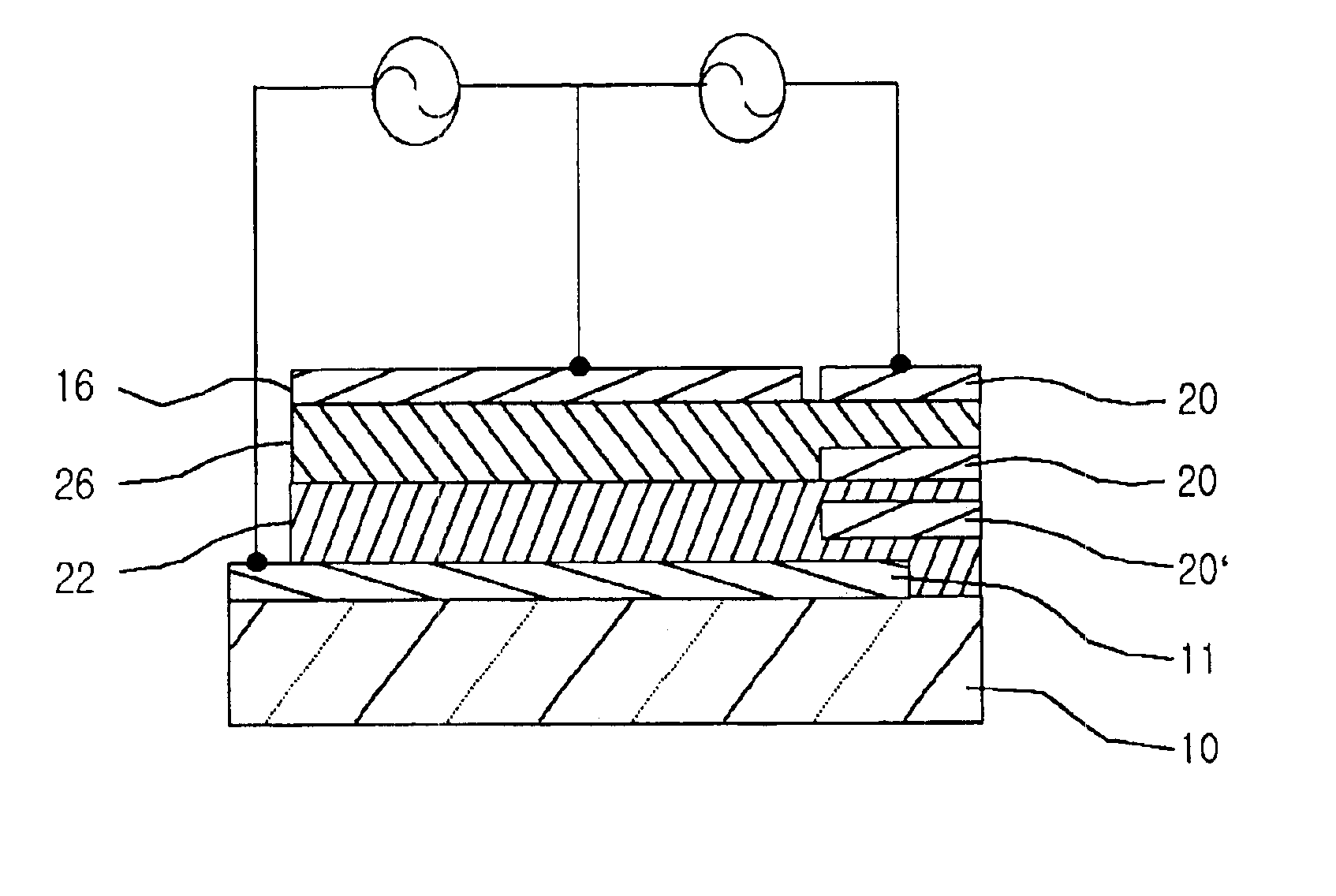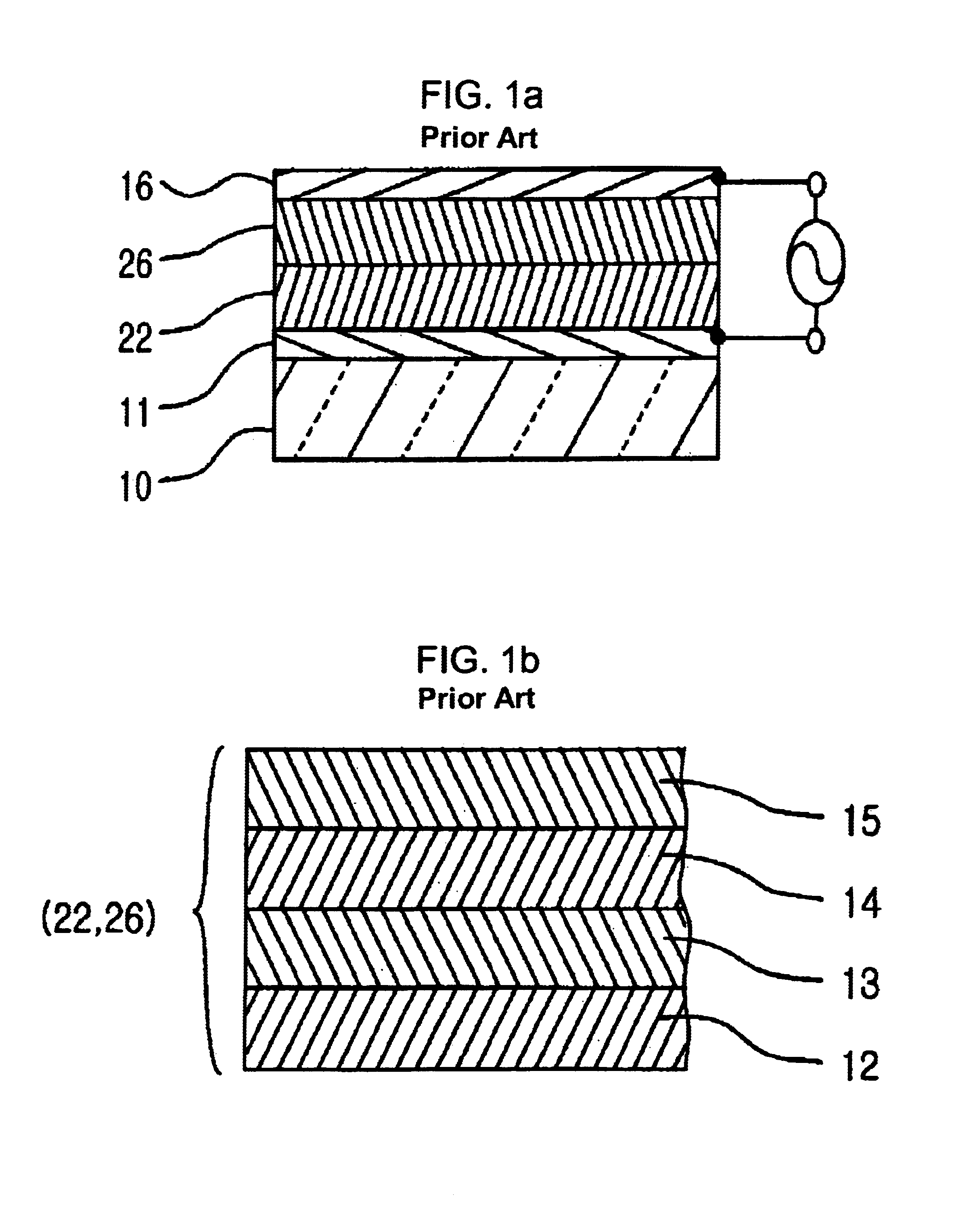Three-terminal organic electro-luminescent device
a three-terminal, organic technology, applied in the direction of static indicating devices, discharge tubes luminescnet screens, instruments, etc., can solve the problems of low external conversion efficiency, complicated methods for adjusting luminance, and large-scale applications, so as to increase efficiency, increase charge carrier injection, and enhance local electric field
- Summary
- Abstract
- Description
- Claims
- Application Information
AI Technical Summary
Benefits of technology
Problems solved by technology
Method used
Image
Examples
example 1
[0086]FIG. 5 is one example of the three-terminal organic EL device in FIG. 4a according to an embodiment of the present invention. As shown in FIG. 5, a three-terminal organic EL device was fabricated, which includes an anode (A) 11 made of ITO, formed on a transparent substrate 10, and organic material layers 22, 26 including a hole injection layer 12 made of m-MTDATA, a hole transporting layer 13 made of α-NPD, a green light-emitting layer 14 made of Alq3, and a electron transporting layer 15 made of Alq3. The organic thin layers were thermally deposited at rate of 0.2 nm / s at 5×10−5 Torr onto an ITO-coated glass substrate with a sheet resistance of 10-20 ohm / square. The thickness of the hole injection layer, hole transporting layer, the organic emitting layer and the electron injection layer are about 40 nm, 20 nm, 60 nm and 20 nm, respectively. Then, a cathode 16 made of Al—Li compound (1000 nm), is formed on the top of the organic material layers at 5×10−5 Torr. Beside of the ...
example 2
[0106]FIG. 14 illustrates one example of the three-terminal organic EL device in FIG. 4b according to an embodiment of the present invention. Following FIG. 14, a three-terminal organic EL device was fabricated, which includes an anode (A) 11 made of ITO formed on a transparent substrate 10, and organic material layers 22, 26 including a hole injection layer 12 made of m-MTDATA, a hole transporting layer 13 made of α-NPD, a green light-emitting layer 14 made of Alq3, and a electron transporting layer 15 made of Alq3. The organic thin layers were thermally deposited at rate of 0.2 nm / s at 5×10−5 Torr onto an ITO-coated glass substrate with a sheet resistance of 10-20 ohm / square. The thickness of the hole injection layer, the hole transporting layer, the organic emitting layer and the electron injection layer are about 40 nm, 20 nm, 60 nm and 20 nm, respectively. Then a cathode 16 made of Al—Li compound (1000 nm), is formed on the top of the organic material layers at 5×10−5 Torr.
[010...
PUM
 Login to View More
Login to View More Abstract
Description
Claims
Application Information
 Login to View More
Login to View More - R&D
- Intellectual Property
- Life Sciences
- Materials
- Tech Scout
- Unparalleled Data Quality
- Higher Quality Content
- 60% Fewer Hallucinations
Browse by: Latest US Patents, China's latest patents, Technical Efficacy Thesaurus, Application Domain, Technology Topic, Popular Technical Reports.
© 2025 PatSnap. All rights reserved.Legal|Privacy policy|Modern Slavery Act Transparency Statement|Sitemap|About US| Contact US: help@patsnap.com



